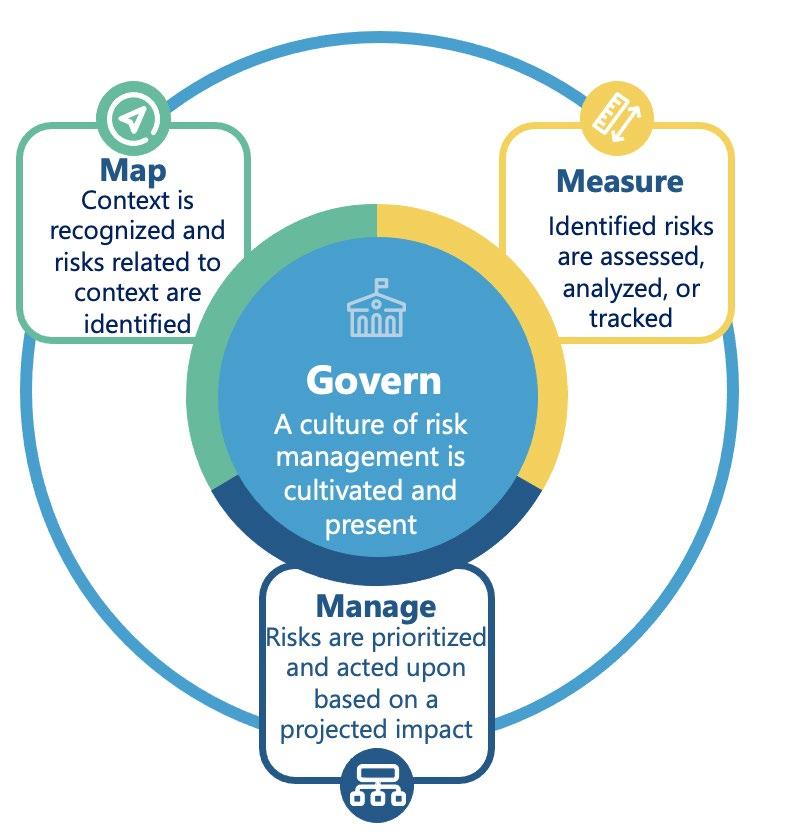
3 minute read
6.3. Measure
The Measure function employs quantitative, qualitative, or mixed-method tools, techniques, and methodologies to analyze, assess, benchmark, and monitor AI risk and related impacts. It uses knowledge relevant to AI risks identified in the Map function and informs the Manage function. AI systems should be tested before their deployment and regularly while in operation. Measuring AI risks includes tracking metrics for trustworthy characteristics, social impact, and human-AI configurations. Processes developed or adopted in the Measure function should include rigorous software testing and performance assessment methodologies that include associated measures of uncertainty, comparisons to performance benchmarks, and formalized reporting and documentation of results. Independent review improves the effectiveness of testing and can mitigate internal biases and potential conflicts of interest. Where tradeoffs among the trustworthy characteristics arise, measurement provides a traceable basis to inform management decisions. Options may include recalibration, impact mitigation, or removal of the system from production. After completing the Measure function, TEVV processes including metrics, methods, and methodologies are in place, followed, and documented. Framework users will enhance their capacity to comprehensively evaluate system trustworthiness, identify and track existing and emergent risks, and verify efficacy of metrics. Measurement outcomes will be utilized in the Manage function to assist risk monitoring and response efforts. It is incumbent on Framework users to continue applying the Measure function to AI systems as knowledge, methodologies, risks, and impacts evolve over time. Practices related to measuring AI risks will be described in the NIST AI RMF Playbook. Table 4 lists the Measure function’s categories and subcategories.
Table 4: Categories and subcategories for the Measure function.
Advertisement
Category
Subcategory Measure: Identified risks are assessed, analyzed, or tracked
MEASURE 1: Appropriate methods and metrics are identified and applied. MEASURE 1.1: Approaches and metrics for quantitative or qualitative measurement of the most significant risks, identified by the outcome of the Map function, including context-relevant measures of trustworthiness are identified and selected for implementation. The risks or trustworthiness characteristics that will not be measured are properly documented. MEASURE 1.2: Appropriateness of metrics and effectiveness of existing controls is regularly assessed and updated. MEASURE 1.3: Internal experts who did not serve as front-line developers for the system and/or independent assessors are involved in regular assessments and updates. Domain experts, users, and external stakeholders and affected communities are consulted in support of assessments. MEASURE 2.1: Test sets, metrics, and details about the tools used during test, evaluation, validation, and verification (TEVV) are documented.
Category
MEASURE 2: Systems are evaluated for trustworthy characteristics.
MEASURE 3: Mechanisms for tracking identified risks over time are in place.
MEASURE 4: Feedback about efficacy of measurement is gathered and assessed.
Subcategory
MEASURE 2.2: Evaluations involving human subjects comply with human subject protection requirements; and human subjects or datasets are representative of the intended population. MEASURE 2.3: System performance or assurance criteria are measured qualitatively or quantitatively and demonstrated for conditions similar to deployment setting(s). Measures are documented. MEASURE 2.4: Deployed product is demonstrated to be valid and reliable. Limitations of the generalizability beyond the conditions under which the technology was developed are documented. MEASURE 2.5: AI system is evaluated regularly for safety. Deployed product is demonstrated to be safe and can fail safely and gracefully if it is made to operate beyond its knowledge limits. Safety metrics implicate system reliability and robustness, real-time monitoring, and response times for AI system failures. MEASURE 2.6: Computational bias is evaluated regularly and results are documented. MEASURE 2.7: AI system resilience and security is evaluated regularly and documented. MEASURE 2.8: AI model is explained, validated, and documented. AI system output is interpreted within its context and to inform responsible use and governance. MEASURE 2.9: Privacy risk of the AI system is examined regularly and documented. MEASURE 2.10: Environmental impact and sustainability of model training and management activities are assessed and documented. MEASURE 3.1: Approaches, personnel, and documentation are in place to regularly identify and track existing and emergent risks based on factors such as intended and actual performance in deployed contexts. MEASURE 3.2: Risk tracking approaches are considered for settings where risks are difficult to assess using currently available measurement techniques or are not yet available. MEASURE 4.1: Measurement approaches for identifying risks are connected to deployment context(s) and informed through consultation with domain experts and other end users. Approaches are documented. MEASURE 4.2: Measurement results regarding system trustworthiness in deployment context(s) are informed by domain expert and other stakeholder feedback to validate whether the system is performing consistently as intended. Results are documented. MEASURE 4.3: Measurable performance improvements (e.g., participatory methods) based on stakeholder consultations are identified and documented.





